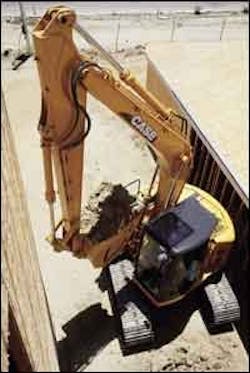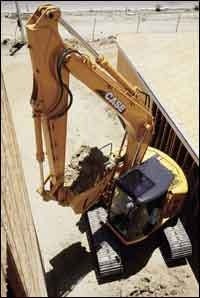Excavators Combine Compactness and Power
For those looking for a crawler excavator that combines the power to tackle significant jobs but also has the compactness to move into areas that would typically be too confining for a large excavator, look no farther than the new breed of excavators in the 20,000- to 40,000-pound range.
The mini-excavator became the machine of choice for small jobs in tight quarters. But it lacked real production capability. Larger excavators had the production but not the compactness. Now, manufacturers have incorporated features found on the mini-excavators into their 20,000- to 40,000-pound excavators. Minimal tail swing, compact radius and, in some cases, offset boom designs give these excavators an advantage when working in confined areas. And when working in confined areas such as those in urban settings and on highway jobs with close-by traffic, the compact features really pay off.
But while incorporating features typically found on minis have redefined these excavators, they also have features that increase production and efficiency. Power management systems have, in a number of cases, been automated. While excavator systems typically have included various work modes with the operator selecting the mode best suited to the work at hand, these modes now are selected for the operator. In other situations, manufacturers have gone to a single work mode, since it was found that many operators simply stayed in the same heavy-digging work mode regardless of the job.
Despite their compact size, these excavators have full-size cabs containing all the ergonomic features of larger machines, and manufacturers have managed to fit these cabs within the compact parameters of the machine with such features as sliding doors instead of hinged doors.
When Komatsu introduced the PC138USLC-2, it carried on its pioneering effort of designing excavators with near zero tail swing. The excavator is able to load within its own track width. The PC138USLC-2 joins the PC128US-2. As an example of how Komatsu compacted its excavators, the PC128US-2 has a tail swing radius that is reduced from that of the PC120 by 2 feet 2 inches. Further, the implement swing was reduced by 1 foot 2 inches from that of the PC120. As a result, the combination of the two reductions allows the PC128US-2 to operate within an 11 foot-4 inch width, or that of a typical highway lane width. To further restrict the excavator's width, the cab door slides instead of opening in the conventional manner, helping to prevent damage.
John Deere's recently introduced 135C has a reduced tail swing, allowing the machine to operate within a 12-foot track. Compared to the 120C, a machine with a 28,840-pound operating weight, the 135C, at 30,440 pounds, has a tail swing radius of 4 feet 10 inches. The tail swing radius of the 120C is 7 feet.
The 135C also is equipped with a single work mode as opposed to several modes. According to Mark Wall, business analysis manager for John Deere Construction & Forestry, "the dig mode allows different options, from heavy-duty excavation to finishing and installation, to be done easily and productively without having to switch modes for the different applications."
Caterpillar introduced automatic boom and swing priority functions on all of its C-Series excavators. This useful feature eliminates the need for power and work modes, with the automatic boom and swing priority automatically selecting the best mode for the application based on joystick movement. Shorter radius design and tail swing design give the new 314CR the ability to work within an 11 foot-4 inch width.
Cat also offers a couple of nice options that further expand the versatility and work scope of its smaller excavators. Blades are available for the excavators and come in three widths. The bolt-on cutting edge consists of three pieces, which can be reused when turned upside down. Since Cat's smaller, compact excavators are designed to work in urban areas, rubber pads are available to fit over the standard shoe. Once installed, the rubber pads eliminate the potential of damage to paved surfaces.
The Pro Control System being incorporated into Case's CX Series excavators monitors and regulates performance. This automatic work mode uses an on-board computer to select the optimal operation mode by sensing load demands and automatically balancing power and speed for greatest efficiency and economy. But if the operator wants to take charge of his own work modes, he can do so using the three manual modes available. These include heavy, standard and light.
Case also pays attention to its excavator cabs, providing operator comforts and a panoramic view of the work area. The entire cockpit slides forward for better visibility into the trench, and a lower right window provides a clear view of the track for easier positioning and loading. Case also provides minimum swing radius models, with an emphasis on power in a smaller package. David Wolf, marketing manager for Case says, "these new Case machines deliver superior dig depths and power in areas as tight as a single highway lane or directly up against a building."
One of Volvo's newest excavators also features an array of electronics. The EC160B is designed with four power modes that respond automatically to the operator's joystick movements and application requirements. Boom, arm and swing priority systems, plus boom and arm flow regeneration are all designed into the system.
Service also is aided by electronics in the Volvo machine. A hand-held unit, the Service Contronic, speeds troubleshooting. All operational data is presented in the machine tracking system, providing all-fault tracking information and service requirements. A computer-aided diagnostic system called VCADS allows the machine function to be tested and changed to specific working or operator requirements.
| Web Resources | ||
| Case www.casece.com |
||
| Caterpillar www.cat.com |
Daewoo www.dhiac.com |
|
| Gradall www.gradall.com |
Hitachi www.hitachiconstruction.com |
|
| Hyundai www.hceusa.com |
JCB www.jcbna.com |
|
| John Deere www.johndeere.com |
Komatsu www.komatsuamerica.com |
|
| LBX Link-Belt www.lbxco.com |
New Holland Const. www.newhollandconstruction.com |
|
| Volvo www.volvoce.com |
||

